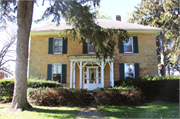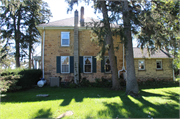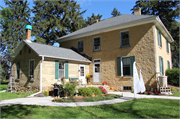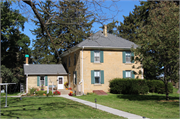Property Record
1227 STATE HIGHWAY 69
Architecture and History Inventory
| Historic Name: | Henry and Janet Boning House |
|---|---|
| Other Name: | Zimmerman's Whispering Pines Farm |
| Contributing: | |
| Reference Number: | 4433 |
| Location (Address): | 1227 STATE HIGHWAY 69 |
|---|---|
| County: | Dane |
| City: | |
| Township/Village: | Montrose |
| Unincorporated Community: | Paoli |
| Town: | 5 |
| Range: | 8 |
| Direction: | E |
| Section: | 11 |
| Quarter Section: | NW |
| Quarter/Quarter Section: | SW |
| Year Built: | 1867 |
|---|---|
| Additions: | |
| Survey Date: | 19772015 |
| Historic Use: | house |
| Architectural Style: | Two Story Cube |
| Structural System: | |
| Wall Material: | Sandstone |
| Architect: | Peter and James Clark |
| Other Buildings On Site: | |
| Demolished?: | No |
| Demolished Date: |
| National/State Register Listing Name: | Not listed |
|---|---|
| National Register Listing Date: | |
| State Register Listing Date: |
| Additional Information: | A 'site file' exists for this property. It contains additional information such as correspondence, newspaper clippings, or historical information. It is a public record and may be viewed in person at the Wisconsin Historical Society, State Historic Preservation Office. 1977 Photo code is: KEH 1/8. 2015- "The Boning House is located on the west side of STH 69, approximately one-half-mile south of the community of Paoli. The property contains a residence [AHI#4433], smokehouse [230060], and the ruins of a privy to the north, as well as a group of agricultural buildings to the south, separated from the house by a gravel driveway lined with mature deciduous trees. Farm buildings consist of two barns [230060, 230061], a modern silo, grain bin [230062], and two other outbuildings [incl. 230063], all of which are grouped along the west side of the road. The Sugar River runs through the property at the rear of the building complex, and the house is surrounded by mature evergreen and deciduous trees and a grassy lawn. A landscaped garden is located north of the house. STH 69 runs north-south and bisects the farm parcel, and mature oak and maple trees line the opposite side of the highway for approximately 700 feet, separating the house and farm buildings from the associated agricultural lands east of the road. Many of these trees are over 4 feet in diameter and were planted by original homesteader Henry Boning. 1. House Contributing Building [4433] The house is a two-story ltalianate residence constructed of local sandstone in 1867. Resting on a stone foundation, the masonry of the front (east) facade is laid using dressed snecked ashlar with raised, tooled mortar joints, while the remaining elevations are roughly dressed or rubble stone with dressed quoins. The hip roof is covered with asphalt shingles and has broad, overhanging eaves with vinyl soffits. Cream brick chimneys with dentilled caps project above the north and south slopes of the roof. Windows throughout feature heavy flat stone headers and sills, and openings contain two-over-two, wood, doublehung sash with functional shutters. A one-story kitchen ell, constructed in 1884, extends from the rear elevation of the main block. The ell has a rubble stone foundation, cream brick walls, and a gable roof covered with asphalt shingles. A brick chimney projects above the ridgeline near the west end. A one-story portico shelters the central main entrance on the symmetrical front facade, and square wood posts with decorative brackets support the flat roof. The entrance consists of a glazed wood door behind a wood storm door, and features full sidelights and a transom. Lower-story windows flank the entrance on either side, and three upper-story windows are evenly spaced across the facade. The north (side) elevation of the main block has two fixed windows at the basement level; three evenly spaced, lower-story windows; and two upper story windows. A concrete block chimney attached to the exterior of the wall vents the furnace in the basement. Both windows on the north elevation of the ell have been downsized and partially infilled with cream brick, although the original stone sills were reinstalled in the openings. A bulkhead door provides access to the basement on the south (side) elevation of the main block, which has two upper-story windows and two lower-story windows. The south elevation of the kitchen ell has a four-panel wood door with a modern storm door, flanked by a single, four-over-four, wood, double-hung window. A concrete walkway from the driveway leads to a small poured concrete slab porch located at the junction of the main block and ell, and provides access to the kitchen entrance and a rear entrance on the west elevation of the main block. The interior of the house largely retains the original layout, consisting of four rooms on each floor of the main block and a one-room kitchen ell. The main block has a central hallway accessed from the front and rear entrances. Two rooms are located on either side of the hallway, and the house's two chimneys vent fireplaces in all four rooms. The central stairs retain their original spindled balustrade and railing, and three of the four fireplaces remain, while the fourth has been replaced with a larger hearth. The house retains many historic interior finishes including bead board wainscoting, wood floors, and built-in cupboards. Although the current owners added closets in several of the downstairs rooms, they left historic millwork in place behind the alterations." -"Henry and Janet Boning House", WisDOT#1693-05-02, Prepared by Mead & Hunt, Inc., (2015). 2015: Currently known as Zimmerman’s Whispering Pines, this farmstead includes a c.1867 house, pump house, barns, silo, and additional outbuildings. The two-story home (AHI# 4433) is constructed of local sandstone with a hip roof. The front (east) facade has a flat roof portico supported by wood square columns with decorative corner bracing. The main entrance is located under the portico and retains the original side lights and transom openings. The house has original two-over-two, double-hung windows with sandstone sills and shutters. Paired chimneys with decorative corbelling are located on either side of the house. An early brick addition on the rear (west) elevation has a gable roof. The original stone well pump house (AHI # 230059), constructed c.1860, is located behind the house to the west. It has a gable roof and retains the original entrance on the east elevation. A c.1880 gable roof barn (AHI# 230060) with vertical wood siding and a concrete block and stone foundation with glass block windows is located south of the main house. A Gothic arch basement barn c.1920 (AHI# 230061) is attached to the east end of the gable roof barn, oriented perpendicular to the earlier structure. The lower level is constructed of concrete block and contains six-light windows. The upper level is clad in a combination of metal and wood siding and the roof is covered with standing seam metal. Two large entrances with sliding doors are located on the east elevation. The attached shed roof milk house is located on the north elevation and is clad in wood. The milk house has six-light windows, a main entrance on the east elevation, and concrete foundation. A recent Harvestore silo is located at the northwest corner of the Gothic arch barn. The additional outbuildings include a c.1950 metal silo (AHI# 230062) with a rounded standing seam metal roof, located south of the barns; a c.1950 gable roof metal shed (AHI# 230063) located south of the silo; and a c.1980 metal pole barn with a retracting garage door on the east elevation, located southwest of the house. The farmhouse was built by Henry Boning, a German immigrant who settled the farm in Montrose in 1856 after over a decade of adventure that included gold mining in California and Australia. Boning initially constructed a log cabin and built the substantial stone farmhouse in 1867. The farmstead consisted of 230 acres by 1873. The property remained in the Boning family as late as 1954. |
|---|---|
| Bibliographic References: | “Henry Boning Celebrates 96th Birthday at Basco; Life Full of Adventure,” Wisconsin State Journal, December 18, 1922. History of Dane County, Wisconsin (Chicago: Western Historical Co., 1880), 1,083. Montrose Township (map, 2”=1 mile), Dane County 1873 (Harrison & Warner, 1873). “Montrose Township, Belleville, Basco, Paoli,” No scale given, in Dane County 1954 (Rockford, Ill.: Derr Map Studio, 1954), 194. |
| Wisconsin Architecture and History Inventory, State Historic Preservation Office, Wisconsin Historical Society, Madison, Wisconsin |





